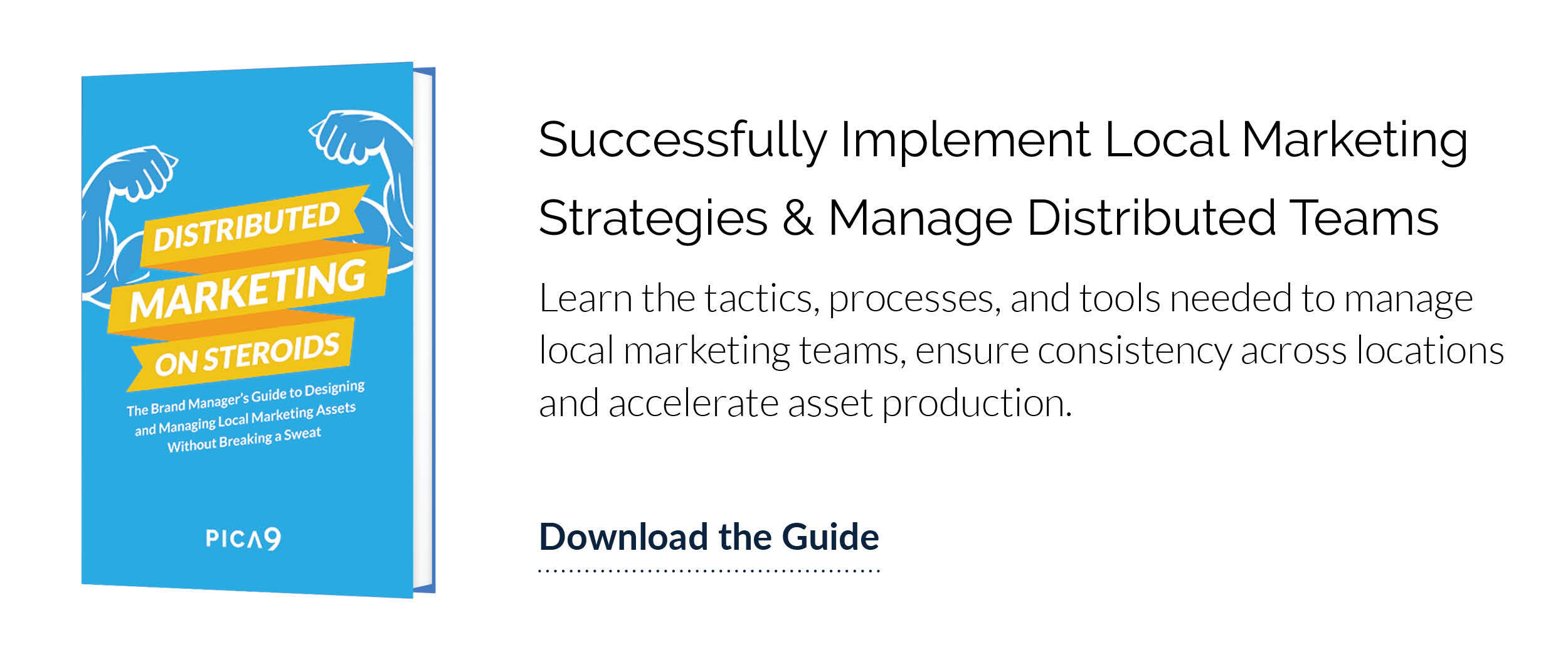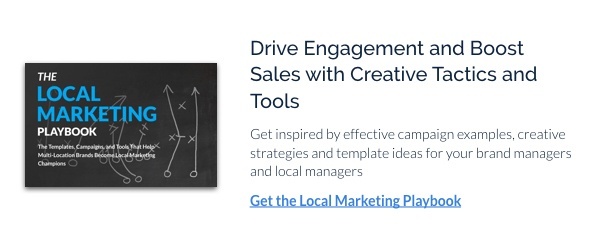Brand managers for distributed enterprise brands are in charge of marketing initiatives that may reach thousands or even millions of consumers. Enterprise marketers today face serious competitive pressures, mounting demand for original content and a media landscape that is only becoming more fragmented.
Gartner Research Director, Bryan Yeager, describes the current marketing climate for the largest companies as one in which, “New channels and platforms that enable marketers to engage audiences are multiplying at a lightning pace.”
What is Enterprise Marketing?
While the definition of enterprise can vary significantly, for the purpose of this discussion, we are defining an enterprise as an organization that operates with annual revenues of $100 million or more.
While marketing for any large organization comes with challenges, geographically-distributed enterprise brands face unique pressures related to their complex, multi-location business models. Distributed enterprise brands may operate with their own unique franchise, dealership, or other affiliate model, but they are all characterized by the fact the the brand management team is significantly removed geographically from their local marketers – by states, time zones or even oceans.
Today's distributed enterprise brand managers are dealing with issues that also impact centralized enterprise brands; including, determining the right mix of print and digital media, understanding changing consumer behaviors and integrating new forms of innovative content into the marketing plan. However, they also have to balance these challenges with issues that are unique to multi-location organizations, including:
-
Supporting a vast network of local marketers, franchisees, or dealers
-
Complicated workflows and a high number of internal stakeholders
-
Balancing local perspectives with brand consistency
Enterprise brand management professionals are tasked with orchestrating the two-way flow of information between the brand management team and local affiliates. Learning how to navigate these unique challenges, relating to business size and model, can result in unlocking some serious advantages.
Challenge #1: Supporting Local Marketers with Limited Resources
Brand managers rarely have enough resources to do everything they need; they don’t have dedicated graphic designers for approving local affiliates’ designs, they may not have enough campaign budget to produce every asset they need, and they don’t have dedicated staff for to constantly be verifying in-store compliance.
In the field, dealerships and franchisees don’t have the same marketing expertise as head office. They’re having to execute advertising without much background in marketing, while balancing HR, bookkeeping, inventory and all of the other challenges that come with running a business. Their resources are also incredibly limited, and they face the challenge of few marketing tools, little marketing knowledge, and not enough people to work on marketing.
Related: Does Your Brand Suffer from Local Marketing Chaos?
Adopting the Local Perspective in Enterprise-Level Decisions
Understanding how your reality as a brand manager compares to your local marketer's experience on the ground helps you understand how to navigate distributed marketing challenges in a way that encourages success at the local level. Communication is necessary to successfully support your locals. A solid understanding of marketing from the local perspective could reduce one-off requests for individual support, dissatisfied franchisees, or other common risks when brand management and locals are misaligned.
Empathy is key to supporting a large number of local marketers. Brand managers that enjoy high local marketer satisfaction communicate actively with their local marketers to understand exactly how and why they're struggling through regular satisfaction surveys. Additionally, they tend to focus the investments they make in process, design and technology on tools that are easy-to-use.
Learn more about how some of the world’s largest enterprise brands support local marketers and improve marketing on the local level: Distributed Marketing on Steroids: The Brand Manager’s Guide to Designing and Managing Local Marketing Assets Without Breaking a Sweat.
Challenge #2: Creating Efficient Marketing Procedures
As a brand manager, your job is to make local marketing easy for your affiliates. However, this isn't simply based on business model or the volume of affiliates you support.
At a distributed organization, you’re dealing with a very large number of stakeholders to run a single campaign. Before a poster is printed and hung in a storefront, the asset may require input and approval from design, brand management, compliance teams and local marketers. While these long and twisting workflows are often necessary, it doesn’t mean that it isn't possible to make them more efficient.
Distributed Marketing Efficiency for Enterprise Marketing
Complicated approval processes and lots of involved stakeholders are a natural part of enterprise distributed marketing. It's not realistic for you to remove approvals, or stop worrying about consistent execution in the field. Your business model is distributed, so your workflows are naturally going to be complex.
Streamlining your workflows for distributed enterprise marketing means documenting what needs to be done and making it easier for everyone involved to follow the process. In practice, this could involve adding new steps to the process, to make it more clear, rather than eliminating steps. Most companies find that technology helps them achieve this.
Tools with built-in approval workflows make it easier for your organization to push work through approval consistently. It allows you to remove unnecessary steps from your processes, and reduces emails from affiliates asking for individualized help.
Challenge #3: Balancing Local Perspectives with Brand Consistency
Consistency is another unique challenge for distributed enterprise marketing. Multi-location brands can very rarely monitor field execution in-person, which leads to concerns that messaging is being modified in a way that doesn't align with brand standards.
Typically, consumers don't distinguish between locally-owned and enterprise-owned businesses when making purchase decisions. They just see brands. Research has found that perceptions of consistency truly matter[1]:
- 60% of US millennials expect consistent experiences when dealing with brands online, in-store, or by phone.
- 64% of people cite shared values as the main reason they have a relationship with a brand.
- 45% of a brand’s image can be attributed to what it says and how it says it.
If a local marketer's in-store signage is the wrong shade of blue, or the messaging is phrased in a way that doesn't "sound" like your brand, it could detract from the customer experience and perceptions of authenticity in messaging.
Scaling Distributed Enterprise Marketing to Local Marketers
There are several options available for brand managers to enforce brand consistency at scale. You could create a highly comprehensive brand standards and guidelines document. In many cases, local affiliates and franchisees may not have the graphic design background necessary to translate color codes and fonts into advertising (let alone use Adobe Creative tools).
Education and knowledge are certainly important. For the vast majority of distributed brands, affiliate on-boarding and training processes focus on branding as a core subject.
Some brands are also uncovering the value of marketing asset management technology in scaling consistency. Using template tools for local marketing execution can enable brand management teams to "lock" certain aspects of local marketing collateral templates that are key to consistency; such as colors, important messaging, or national brand offers.
By allowing your local marketers to edit information that's important to their business, such as their address or local offers, while "locking" other attributes, you can balance local customization with brand consistency.
Achieving True End-to-End Efficiency in Localized Enterprise Marketing
Distributed enterprise brands have to navigate the same strategic, technology-related, and scalability issues as enterprises without multiple locations. In addition to the challenges of designing successful marketing campaigns for consumers in 2017, they also have to solve unique challenges related to distributed business models, streamline complex marketing workflows, and balance consistency with local perspectives.
Many of today's most effective brand managers are drawing from a range of tools to hit and exceed their goals. With empathy for your local marketer's perspective, you can build a playbook that encourages success for all of your stakeholders.
Streamlining your workflows is challenging, but not impossible, and the key is likely consistency. Balancing consistency and local perspectives can be achieved with a mixture of continued educational efforts and technology. Enterprise distributed brands may be up against some tough challenges, but success is possible.
CampaignDrive by Pica9 is a distributed marketing platform created for enterprise brands to help achieve brand compliance and local marketing success.
Sources
- https://www.bopdesign.com/bop-blog/2015/10/15-crazy-branding-stats/






